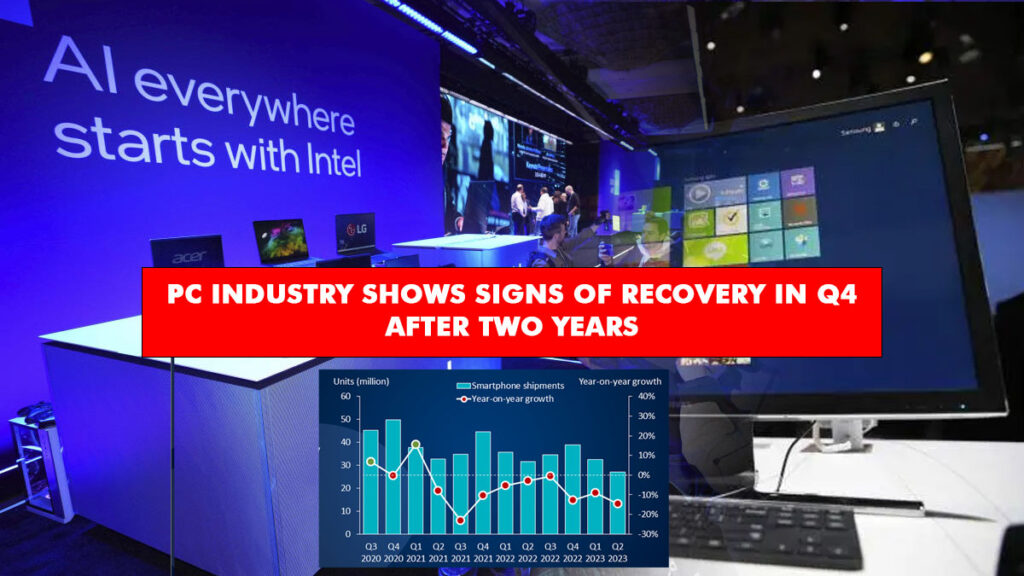“Amidst economic uncertainties, the PC Industry witnesses a modest yet significant upturn in Q4 2023, marking a potential turning point after two years of decline.”

Table of Contents
Positive Momentum as PC Shipments Increase in the Fourth Quarter of 2023
Despite facing its worst sales performance in 17 years in 2023, the PC sector appears to be turning things around. Preliminary research from Gartner indicates that PC shipments increased significantly in the fourth quarter of 2023—the first positive gain in eight quarters.
More specifically, the industry shipped 63.3 million units overall during the quarter—a slight increase of 0.3% over the same period last year. Even with this slight improvement, the industry moved 241.8 million PCs in the year, a significant 14.8% decrease. According to Gartner, this decline resulted in the lowest yearly shipment levels since 2006.
With a positive statement, Gartner researcher Mikako Kitagawa said, “The PC market has hit the bottom of its decline after significant adjustment.” One of the key factors that had plagued the sector over the previous two years, according to Kitagawa, was the normalisation of inventory in the fourth quarter of 2023. This gradual increase is seen to be a sign that supply and demand are now balancing out.
Kitagawa did, however, issue a warning that this equilibrium would not last long, pointing out possible risks from geopolitical and economic instability that could sabotage the PC market’s recovery from decline. Despite encouraging indicators in the fourth quarter, there are still areas of weakness throughout the world, with China recovering more slowly than other countries.
Regional Variances Impacting the Global PC Market
According to Gartner’s report, the Asia Pacific area had an 8% fall in shipments, and Greater China was a major factor in the region’s poor performance. In contrast, with shipments increasing by 8.7%, the EMEA region experienced the greatest rise. With more shipments, North America also helped to contribute to the encouraging trend.
This slight rebound coincides with the industry’s strategic shift towards AI PCs, which is being driven by companies like Microsoft, chipmakers, and PC makers. AI PCs—generally speaking, computers with neural processors that can run AI applications natively—are drawing interest as the next big development potential for desktop and laptop computers.
The introduction of Microsoft’s AI-powered Windows Copilot on Windows computers demonstrates the company’s leadership in incorporating AI capabilities into consumer electronics. Furthermore, the company’s dedication to developing AI technology for consumers is emphasised by the Copilot key seen on Windows desktop and laptop keyboards.
Anticipated Rebound in 2024: A Crucial Period for the PC Industry
Industry watchers believe that the PC industry will see a recovery in 2024. Consumers and organisations that bought laptops and desktop computers in 2020 during the early phases of the epidemic are now nearing the end of their useful lives. Millions of people around the world tried to get hold of PCs so they could work and play in the comfort of their own homes while lockdowns were in place.
Consequently, there was little motivation for consumers and businesses to upgrade their systems, which led to a sharp decrease in PC sales in the ensuing years. But even as these gadgets go closer to being outdated, demand is growing once more.
Beyond PC makers, a wide range of businesses, including chip and memory producers, and other component builders, stand to gain from this upsurge in demand. Major players such as Intel, AMD, and Nvidia are expected to gain a lift as consumers turn to new laptops and desktops. In a similar vein, Microsoft stands to benefit financially from this predicted revival of the PC market, as it receives a significant portion of its revenue from OEM partners’ sales of Windows licences.
In conclusion, despite navigating through a difficult time characterised by a protracted decline, the PC industry appears to be headed towards recovery based on encouraging signs from the fourth quarter of 2023. In order to maintain steady growth in the upcoming years, the industry needs to manage possible obstacles as the global landscape changes.